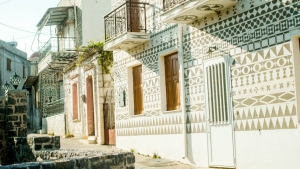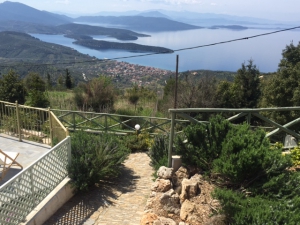ABOUT US
XpatAthens
Thursday, 23 April 2015 17:17
Airbnb Athens Bookings Boosts Local Economy By 69 Million Euros
Hospitality platform Airbnb has boosted the local economy by 69 million euros, supported over 1,000 jobs and is attracting new visitors to Athens, a study released on Wednesday found.
The survey, conducted between October 2013 and September 2014 jointly by Airbnb and Athens University professor Christos Genakos, revealed that the platform complements the existing tourism industry and spreads the economic benefits across Athens to new neighborhoods and small businesses.
According to the findings, Airbnb is attracting new visitors to Athens, with 71 percent of guests visiting for the first time and 67 percent reporting that they were more likely to return. The platform has 11,500 entries for Greece, 2,500 of which are for Athens, a figure that has doubled since 2009. Airbnb hosts’ properties span 25 neighbourhoods in the Greek capital.
Besides contributng to the local economy, the community-driven hospitality platform also helps locals who share their homes to stay afloat in difficult economic times. The typical Athenian host shares their home with guests for about 68 nights per year, with 68% of hosts saying they rely on this income.
“Airbnb hosts attract new visitors to Athens, who are looking for an authentic, local travel experience,” explains Airbnb Regional Manager Jeroen Merchiers.
“This helps boost Athens’ tourism market and support the local economy while extending the economic benefits beyond the popular city spots. Meanwhile, Airbnb hosts have an extra income to sustain themselves and their families in this difficult economic period,” he adds.
Airbnb guests stay an average of 3.6 nights and spend 551 euros over the course of their trip. Some 26 percent said they would not have come or would not have stayed as long without Airbnb, while 91 percent would recommend the Airbnb property they stayed in to friends and family.
Guests opting for Airbnb are looking for genuine experiences with 75 percent saying they wanted to stay in a specific neighbourhood. In the meantime, 98 percent of hosts provide their guests with personalised recommendations on alternative neighbourhoods to visit and 70 percent provide their guests with locally produced products.
To read more, please visit Greek Travel Pages.
Published in
Local News
Tagged under
Thursday, 23 April 2015 08:52
Heineken Exports From Greece To China & Italy
Athenian Brewery announced on Thursday it was launching Heineken beer exports to the Chinese and Italian markets, as the first batch set off on its long trip to the Far East.
The beer for export will be produced at the brewery’s Patra production unit, in an investment project amounting to 2 million euros. The decision was made in association with the parent company in Amsterdam and will boost employment in local communities as it involves the use of Greek raw materials.
“At first the new production line will be covered by existing employees, but this summer will see the gradual hiring of some seasonal workers,” Athenian Brewery’s managing director Zooullis Mina promised.
To read more please visit: ekathimerini
By Anestis Dokas
Published in
Local News
Tagged under
Tuesday, 21 April 2015 17:21
5 + 1 Things To Do On Paxos Island
The myth says that Poseidon wanted to create a love nest for him and Amfitriti, so with his trident he hit the southern part of Corfu and created the small islands of Paxos and Antipaxos. The island of Paxos is located in the Ionian sea very close to Corfu. The only way to get there is by boat from Corfu or as a day excursion from Parga (Greek mainland).
Here are 5 things you can do on the beautiful island of Paxos.
1) Visit Gaios
The village of Gaios is the capital of Paxos and the central port of the island. As you enter Gaios by boat, you will see two green islands. The island of Panagia and the island of St Nicholas. On the island of St Nicholas you will find a venetian fortress built using designs of Leonardo da Vinci. If you would like to visit the fortress you must take permission from the municipality.Other interesting things you could do in Gaios are stroll through the narrow roads called (kantounia) , visit the museum of Paxos and the municipal gallery.
2) Visit Loggos
The small fisherman’s village of Loggos, is a traditional Eptanisian village with stone houses and colored windows. It used to be a commercial center in the past. At one side of the port you can see the abandoned factory that used to make soap. Nowadays the picturesque village of Loggos is famous for its great restaurants.
3) Visit Lakka
Lakka is another traditional village on the north side of Paxos island. It has a more cosmopolitan air since you will see a lot of yachts. There is also a yachting club in the area. Other interesting things are the lighthouse and the church of Ypapanti. They are both within walking distance from the village.
To read more, please visit: Travel Passionate.
by Chrysoula Manika
Published in
Travel Greece
Tagged under
Tuesday, 21 April 2015 10:57
'National Geographic Traveler' Tells World To Visit Greece
Finally! Greece is back on the map as a great holiday destination.
For its May issue, National Geographic Traveler UK urges holidaymakers and restless souls across the globe to “Return to Greece” and cites 11 reasons to explore the Aegean and beyond.
Though Greece may have experienced “a tumultuous few years, a new government and rumblings of a new (old) currency”, the National Geographic story dedicates 15 pages to what it describes as one of the most popular destinations for British travellers.
New investments, increasing number of flight connections, alternative hospitality choices are all drawing visitors to Greece, National Geographic Traveler UK editor Pat Riddell explains, adding that the Mediterranean country is now much more than the loved and highly sought after sea and sun.
To read more, please visit: gtp Headines
Published in
Greece In The News
Tagged under
Monday, 20 April 2015 17:26
Hellenic Seaplanes Includes New Greek Islands
Greek company Hellenic Seaplanes has expanded its waterway network to include the ports of the North Aegean islands Chios, Psara and Oinousses, according to an announcement made on Thursday 16th April 2015.
The Chios Municipal Port Authority committee has awarded “Ydatodromio Chios, Psara and Oinousses IKE”, a subsidiary of Seaplanes Greece SA / Hellenic Seaplanes SA, the contractor rights.
The “Ydatodromia Chios, Psara and Oinousses IKE” will now apply for a license to operate the waterways at the ports.
According to Hellenic Seaplanes, which aims to connect the Greek islands with the mainland via waterways, some 50 waterways are in the process of creation and licensing countrywide.
To read more about this initiative, please visit: Greek Travel Pages.
Published in
Local News
Tagged under
Monday, 20 April 2015 11:33
10 Reasons To Visit Athens
There are many reasons why Athens is such a great city to visit. Here are 10 reasons why everyone should visit Athens at least once!
1 – It’s full of monuments of the famous ancient Greek civilization.
1 – It’s full of monuments of the famous ancient Greek civilization.
The Greek civilization is one of the oldest and biggest in Europe, stretching back more than 3000 years. Here you can find dozens of monuments from the distant pant. Of course the most recognized is Acropolis. A hill in the centre of city, with ancient temples and buildings. The biggest and most important is the Parthenon, which is dedicated to the goddess Athena. But it’s not only Acropolis. Across the city there are temples, libraries, bridges and a lot of other monuments. And of course there are two museums that you can’t miss : the Archaeological museum and the museum of Acropolis, one of the most astonishing in the world.
2 – Democracy was born here.
Democracy is the most common form of government nowadays. Did you know that it first appeared in the city of Athens, around 500 B.C. ? It comes from the greek words “demos” (that means people) and “cratos” (that means power). The Athenian Democracy was the most direct form of it, as the institutions of the city were consisted of the citizens, and the decisions were made by them for them. Today you can take a walk to the hill of Pnika or to the area of the Ancient Market, places where people used to meet back then to discuss about the important public issues and make the decisions.
3 – Theatre started in Athens.
The first theatrical plays were written in Ancient Athens, and were part of the festivals that honoured the god Dionysus. There were three types of plays: tragedies, comedies and satyr. The actors wore always masks and unlike today, back then they were only men. The most famous tragic writers were Sophocles, Euripides and Aeschylus, and Aristofanes on comedy. Near Acropolis you can find the ruins of the theatre of Dionysus, the biggest in the city on its Golden Era. If you are lucky, you can also watch a play on the Roman theatre of Irodis and feel like taking part in these ancient festivals.
4 – Just three words. Modern Olympic Games.
Of course most of you know that Olympic Games started in Ancient Greece. But the first modern ones were held also in Athens, in 1896. Pierre de Coubertin was the one who had the idea and in the spring of that year, around 250 athletes from 14 countries took part in the Games. The opening ceremony was a huge success, with 80000 spectators coming to the Panathenian Stadium. Today, it’s the finishing point of the Athens Classic Marathon. 108 years later, Athens was again the hosting city. This time there were more stadia and thousands of athletes from 202 countries. For 20 days, it was the centre of the world in one of the most important moments of our modern history.
5 – Want to have fun? You are in the right place.
Athens is the perfect destination for those who seek fun. 24/7, you can always find something to do. Are you a coffee, tea or chocolate lover? There are many places where you can have a drink. Especially near Monastiraki, Plaka or Thisio, with an excellent view of Acropolis. But Athens is also known for its nightlife. Here the people go out every day from dusk till dawn. If you are an alternative person or want something more quiet, you can drink a beer or your favourite alcohol in one of the many bars & pubs across the town. Or just enjoy some wine listening to traditional Greek music. And if you fancy dancing till you drop, go to a night club or one of those bars with their super parties. So you can see how hard can the Greeks party.
6 – Sea, sea and sea again.
We are so lucky to be less than an hour away from the sea here in Athens. Many of us can even see it from our terraces. On the hot days of summer, we have the chance to go to one of the many beaches around the city. Of course Greek islands are a lot better than this, but if you can’t visit them, don’t worry. There are plenty of beautiful coasts around Athens where you will have the feeling that you are miles away from a metropolis. And all of them are easily accessible by bus or the tram.
4 – Just three words. Modern Olympic Games.
Of course most of you know that Olympic Games started in Ancient Greece. But the first modern ones were held also in Athens, in 1896. Pierre de Coubertin was the one who had the idea and in the spring of that year, around 250 athletes from 14 countries took part in the Games. The opening ceremony was a huge success, with 80000 spectators coming to the Panathenian Stadium. Today, it’s the finishing point of the Athens Classic Marathon. 108 years later, Athens was again the hosting city. This time there were more stadia and thousands of athletes from 202 countries. For 20 days, it was the centre of the world in one of the most important moments of our modern history.
5 – Want to have fun? You are in the right place.
Athens is the perfect destination for those who seek fun. 24/7, you can always find something to do. Are you a coffee, tea or chocolate lover? There are many places where you can have a drink. Especially near Monastiraki, Plaka or Thisio, with an excellent view of Acropolis. But Athens is also known for its nightlife. Here the people go out every day from dusk till dawn. If you are an alternative person or want something more quiet, you can drink a beer or your favourite alcohol in one of the many bars & pubs across the town. Or just enjoy some wine listening to traditional Greek music. And if you fancy dancing till you drop, go to a night club or one of those bars with their super parties. So you can see how hard can the Greeks party.
6 – Sea, sea and sea again.
We are so lucky to be less than an hour away from the sea here in Athens. Many of us can even see it from our terraces. On the hot days of summer, we have the chance to go to one of the many beaches around the city. Of course Greek islands are a lot better than this, but if you can’t visit them, don’t worry. There are plenty of beautiful coasts around Athens where you will have the feeling that you are miles away from a metropolis. And all of them are easily accessible by bus or the tram.
To read more, please visit: The Travel Issue
By Konstantinos Kotzias
Published in
City Discovery
Tagged under
Monday, 20 April 2015 10:51
Luxury Buy-To-Let Properties In Desirable Areas Bring High Returns
Greek holiday homes offer the highest returns compared to those in other Mediterranean countries, particularly for people looking to make an investment that can generate income as well as serve as a luxury vacation home.
A recent survey by real estate company Algean Property showed that luxury properties in places such as Mykonos, Elounda on Crete, Rhodes and Halkidiki offer the highest yields in the market, in that order.
To read the complete article, please visit: ekathimerini.com
By Nikos Roussanoglou
Published in
Greece In The News
Tagged under
Saturday, 18 April 2015 13:35
International Travel Bloggers Share Best Places In Greece
When 11 International Travel Bloggers were asked, 'Which is the best place you have been to in Greece?' here is what they answered:
"With a question like this, I have to stay true to my heritage – and with good reason. My family is from the island of Chios -- the fifth largest Greek island, located in the Aegean sea, a mere 30-minute ferry ride from mainland Turkey and a 30-minute flight from Athens airport. From the tulip blooms in March, to the mastic tree orchards in the South; from the black- pebbled beach of Mavra Volia, to the crystal clear waters of Nagos; from the stunning medieval village of Mesta, to the haunting ghost town of Anavatos, there is so much to see in Chios. With its rich history (Christopher Columbus is rumoured to have come from here), unique beaches, mouth-watering food, breathtaking mountain and sea views, Chios has so much more to offer than your typical Greek island getaway. Rarely making the list of ‘must-see Greek islands’ Chios truly is one of Greece’s many hidden gems." Maria Carras, Greece, Sun and Shine blog
"The best place (s) for me in Greece are the Greek islands. They are all so wonderful to visit and to get to know. One of the most memorable island destinations is Santorini. It is so unique compared to all of the islands. As for one of my favourite islands in general I’d say Ithaca. It’s small, green, less touristic and has a wonderful energy about it. I also discovered Naxos last year and that was great too. There are so many…. This is a problematic question… LOL." Marissa Tejada, USA living in Greece, My Greece, My Travels and Chasing Athens
"We loved Athens, with all of the ancient ruins. We also loved the islands, especially Hydra, with it's laid back atmosphere – we wish we had spent more time there on our last trip. Next time!" Sean Boyle and Jennifer Evans,USA (and beyond!), Venturists
"Leros Island in the Dodecanese. Oh, and Rhodes Old Town. Oops, that’s two places! I don’t think it’s possible to name just one." Rebecca Hall, British living in Greece, Life Beyond Borders blog
To read more, please visit: Passion for Greece
"Leros Island in the Dodecanese. Oh, and Rhodes Old Town. Oops, that’s two places! I don’t think it’s possible to name just one." Rebecca Hall, British living in Greece, Life Beyond Borders blog
To read more, please visit: Passion for Greece
by Elena Sergeeva
Published in
Travel Greece
Tagged under
Saturday, 18 April 2015 09:12
International Day On Monuments & Sites
Saturday April 18th is International Day On Monuments & Sites in celebration of ICOMOS' 50th Anniversary. In Greece, all museums and archaeological sites will have free entrance for the entire day!
International Day On Monuments & Sites is a global day established by UNESCO and the International Council on Monuments and Sites (ICOMOS).
To learn more and see how this day is celebrated around the world, please visit: http://www.icomos.org/en/.
Published in
Local News
Tagged under
Friday, 17 April 2015 13:41
Greek Easter In Pelio
With the combination of Greek Easter and 20+ degree spring weather, the long weekend called for a road trip. So we packed up a car with a few friends and headed out on Friday towards Pelio. It was my first time in Pelio since I was a kid – and it won’t be my last.
Pelio is actually the mountain range in the southeastern part of Greece’s Thessalia region, easily reachable by car, a few hours drive from Athens via Volos. This is an area of beautiful mountain drives, hiking trails, springs and waterfalls, beaches and even ski hills in winter. Google tells me there are 24 villages nestled across the region, with beautiful traditional homes and mansions, many of which have been turned into hotels and inns. This is the place to go for long mountain drives, dramatic scenery and lovely beaches.
We stayed in the village of Milies, in a stone-built inn overlooking a deep valley – more or less centrally located for easy driving access to the region. For Easter we had booked lunch at a place called Lagou Raxi. This is a very nice ‘country hotel’, newly built on a mountain-top in the village of Lafkos in South Pelio, with seriously stunning views down to the sea. Lagou Raxi is a beautiful spacious property, with a fantastic swimming pool, nicely decorated and delicious food in the restaurant. The owners, Sue and Christian, are fellow expats who have made Lafkos their home and have clearly poured their hearts into this unique property. In fact, Sue and Christian become your hosts during your stay here, and make you feel right at home. But this is much more than just a hotel – they also offer scheduled activities throughout the year, from yoga to painting to hiking. Not hard to get used to this…
One thing is for sure – I will add Pelio to my ever-growing list of must-see places in Greece.
Until next week,
Published in
My Week In Athens
Tagged under










